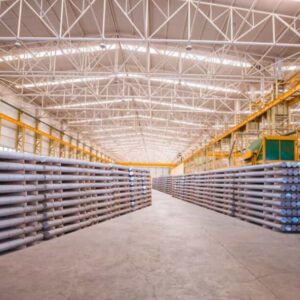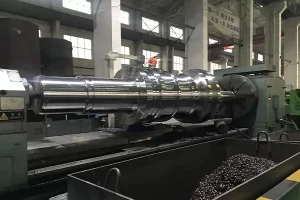Tool Steel for High-Temperature Applications: Strength and Stability
Introduction
Tool steels comprise a versatile range of alloy steels engineered for use in tooling applications requiring hardness, wear resistance, and the ability to withstand high temperatures and stresses. While conventional tool steels perform well up to around 600°F, emerging tool steel alloys offer dramatically improved strength and dimensional stability at elevated temperatures exceeding 1000°F.
These high temperature tool steels empower reliable tool performance in hot work manufacturing processes like forging, die casting, extrusion, and more demanding operating environments. This article explores high temperature tool steel compositions, processing methods, properties, and applications capable of thriving where conventional tooling steels fall short.
Demanding Needs of High Temperature Tooling
 The challenges of tooling applications in hot work environments create particular demands including:
The challenges of tooling applications in hot work environments create particular demands including:
- Strength and hardness at high temperatures
- Resistance to thermal fatigue and cracking
- Reduced thermal expansion and distortion
- Oxidation and corrosion resistance
- Abrasive wear resistance
- High temperature creep resistance
- Thermal shock resistance
These challenging conditions impose limits on conventional tool steels above about 600°F. Excessive softening, wear, and dimensional changes occur. Advanced high temperature tool steels provide a solution.
Alloy Design for High Temperature Tool Steels
To achieve strength, hardness, and stability at elevated temperatures, high temperature tool steels are alloyed with elements including:
Tungsten
Tungsten imparts hot hardness, creep resistance, and high temperature strength. It forms hard carbides that strengthen and resist softening.
Molybdenum
Molybdenum additions enhance high temperature strength, creep resistance, hardenability, and toughness. Molybdenum carbides provide additional strengthening.
Vanadium
Vanadium forms very hard V-carbides that boost wear resistance, temper resistance, and hot hardness at high temperatures.
Cobalt
Cobalt maintains hardness at high temperatures by dissolving in the iron matrix and slowing softening processes. It also improves hot workability.
Chromium
Chromium is a key alloying element that increases hardenability, oxidation resistance, and strength at elevated temperatures.
When optimally combined, these alloying additions enable tool steel stability and durability at unprecedented high temperature limits.
Processing for Strength and Stability
In addition to composition, processing is also vital to achieve the desired balance of properties:
Melting
Vacuum induction melting or vacuum arc remelting is used to produce high purity tool steel ingots with controlled chemistries.
Forging
Forging achieves fine, uniform microstructures optimal for heat treatment. Hot forging may be applied to improve workability of these hard alloys.
Heat Treatment
Careful austenitization, quenching, and tempering develops the required combination of hardness, strength, and toughness at high temperatures.
Surface Treatments
Coatings like TiN or AlTiN applied via PVD improve oxidation and wear resistance. Nitriding can also enhance high temperature performance.
When melted, forged, heat treated, and finished properly, high temperature tool steels offer unprecedented capabilities.
Leading High Temperature Tool Steel Grades
Some of the most widely utilized tool steel grades for high temperature stability include:
H13
A chromium-molybdenum-vanadium alloy tool steel that offers an exceptional balance of wear resistance, strength, and toughness from room temperature up to about 1000°F. It has good machinability in the annealed state.
H11
Has similar composition to H13 but without vanadium. This improves machinability and grindability in exchange for slightly reduced heat resistance compared to H13. Still useful up to about 750°F.
H19
A tungsten-molybdenum high speed tool steel that exhibits very high hardness and compressive strength up to 1100°F. Offers good thermal fatigue resistance and ability to cut or form materials at high temperatures.
H21
Another tungsten-molybdenum tool steel with slightly lower tungsten and higher chromium content than H19. Has enhanced temper resistance and thermal shock resistance. Excels up to 1000°F.
H26
Contains increased tungsten and cobalt alloying for exceptional hot hardness up to 1200°F. Used for the most extreme temperature tooling applications where high depth of hardening is also required. Difficult machinability.
High Temperature Stainless Grades
Stainless tool steels like 440C or D2 modified with cobalt and tungsten additions provide stainless corrosion resistance and hardness up to 1100°F.
These alloys define the current state-of-the-art for tooling materials used in hot work environments.
Key Properties and Performance
Thanks to specialized alloying and processing, high temperature tool steels offer greatly expanded thermal capabilities:
Hardness
Hardness ratings of HRC 50 and higher are maintained up to temperatures exceeding 1000°F in high temperature tool steels. This ensures durable cutting, forming, and shaping capability.
Creep Strength
Excellent creep strength up to 1200°F resists high temperature deformation under load. This minimizes dimensional distortions or failures during extended hot service.
Oxidation Resistance
formations of protective surface oxides aided by additions like chromium and aluminum maximize high temperature oxidation resistance.
Thermal Fatigue Strength
Carefully controlled residual stresses and microstructures improve thermal shock load cycling capacity and resistance to heat checking cracks.
abrasive Wear Resistance
Extremely hard carbides of elements like vanadium and tungsten resist abrasive wear at high temperatures during hot metal cutting, forming, or casting.
By optimizing these properties, high temperature tool steels retain stability and withstand punishing conditions.
Typical Applications
 The unique benefits of high temperature tool steels make them well suited for:
The unique benefits of high temperature tool steels make them well suited for:
Hot Forming Dies
Forging, stamping and forming dies benefit from hardness, strength and wear resistance at high temperatures up to and exceeding 1000°F
Die Casting Tooling
Demanding die casting molds withstand metal pressure and temperatures around 1300°F relying on high temperature tool steel construction.
Extrusion Tooling
Extrusion presses for metals and polymers apply pressures over 50,000 psi at temperature beyond 750°F. High temperature tool steels resist wear and deformation.
Welding/Soldering Fixtures
Tooling for welding, brazing, and soldering processes withstand localized heat exposure relying on the thermal properties of high temperature tool steels.
Hot Machining
Milling, turning and cutting tools maintain hardness and cutting edge integrity when machining alloys at high temperatures with high temperature tool steel compositions.
Hot Trimming, Piercing, Bending Dies
Trim, pierce and bend tooling operates at 900-1200°F when processing hot forged or cast components. High temperature tool steels endure these conditions.
Hot Platen Presses
Heated press platens for laminating, molding and other thermal processes rely on dimensionally stable, hardened high temperature tool steels.
Thermal Processing Molds
Tooling for processes like injection molding thermoplastics or powder metal sintering withstand repeated high temperature cycling using specialized hot work tool steels.
Kilns and Furnace Fixtures
High temperature furnace and kiln fixtures utilize oxidation resistant, high temperature tool steels due to heat levels approaching or exceeding 1000°F.
With their exceptional thermal properties, high temperature tool steels empower reliable tooling performance where most other tool materials quickly fail.
Developments in High Temperature Tool Steels
Advancements in high temperature tool steels target improved economic manufacturability while reaching ever higher temperature capabilities:
Near-Net Shape Processing
Innovations in powder metallurgy and metal injection molding allow near-net shape fabrication to minimize costly machining of these difficult to cut alloys.
Complex Carbide Formers
Alloying additions beyond the common molybdenum, tungsten and vanadium offer potential performance benefits. Elements like tantalum, niobium and zirconium are being explored.
Coatings
Improved high temperature PVD and CVD coatings guard against wear, friction and oxidation during hot forming and cutting duty. Multilayer coatings exceed the limits of existing coating technologies.
Surface Treatments
Hybrid surface hardening combining carburizing and nitriding improves high temperature stability. Laser treatments produce localized property enhancements.
Modeling
Advanced computer simulation and modeling uncovers optimized compositions and processing parameters for next-generation high temperature tool steel development.
Grain Refinement
Innovative alloying and processing produces tool steels with nano-scale carbides and grains for superior high temperature strength. High precision 3D printing capabilities assist these efforts.
Operational Analysis
Real-time tool monitoring and predictive analytics will enable proactive optimization of high temperature tool steel performance in demanding hot work conditions.
Ongoing advances will further unleash the potential of high temperature tool steels for critical manufacturing applications.
Conclusion
High performance tool steels strengthened with strategic alloying additions of tungsten, molybdenum, vanadium, cobalt and more enable tooling materials that resist softening, wear, and distortion at exceptional temperatures up to and beyond 1000°F. Hot work manufacturing processes benefit from hardened tooling that maintains form and function despite extreme pressures and temperatures that would easily destroy conventional tooling.
With their unparalleled elevated temperature capabilities, high temperature tool steels will continue proving indispensable across hot forming, casting, sintering, welding and machining production where high temperatures pose challenges. By leveraging innovations in alloy development, precise processing, coatings and modeling, high temperature tool steels have even greater potential ahead to push the boundaries of reliable tooling performance in demanding environments.
Frequently Asked Questions
What temperature range do high temperature tool steels cover?
Depending on grade, high temperature tool steels offer stable hardness and dimensional stability typically between 700-1200°F. Specialized grades can sometimes perform up to 1300°F.
What causes tool steels to soften at high temperatures?
Excessive heat causes tool steel alloy carbides to dissolve and transform into softer phases that reduce hardness, strength and wear resistance. High temperature grades resist these changes.
Which is better, a tungsten or molybdenum high temperature tool steel?
Molybdenum grades cost less but tungsten alloys perform better at the most extreme temperatures. For applications above 1100°F, tungsten-type H19 or H21 is recommended.
What coating improves high temperature tool steel performance the most?
Advanced PVD coatings like TiAlN or CrAlN deposited by cathodic arc evaporation provide the best combination of hardness, lubricity, and oxidation resistance at high temperatures. Multilayer coatings also excel.
How should you heat treat a high temperature tool steel?
Careful austenitizing around 1950-2100°F followed by rapid oil quenching and low temperature tempering around 1000-1100°F produces optimal microstructures and properties. Triple tempering improves toughness.
Can high temperature tool steels be 3D printed?
Yes, hot work tool steel powders like H13 can be successfully processed via laser powder bed fusion additive manufacturing after accounting for residual stress. This enables complex cooling geometries.
What causes thermal fatigue cracking in tool steels?
Alternating heating and cooling cycles create cyclic stresses that cause crack initiation and propagation at high temperatures. Thermal fatigue cracking eventually leads to tool failure.
What alloys perform best when machining or cutting over 1000°F?
Cobalt enriched tungsten tool steels like H26 and H27 maintain extreme hardness and retain a sharp cutting edge at very high temperatures exceeding 1000°F during machining.
How much more expensive are high temperature tool steels than conventional tool steels?
The specialty alloys and extra processing result in high temperature tool steels costing approximately 25-75% more than conventional cold work tool steel grades. Improved tool life helps offset the higher costs.
What are some of the latest advancements around high temperature tool steels?
Emerging approaches like metal injection molding fabrication, nanostructured carbide strengthening, and functionally graded compositions point toward next generation high temperature tool steels with expanded capabilities.

